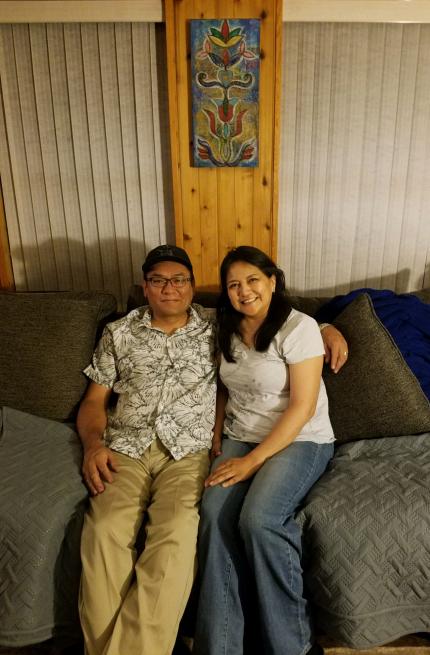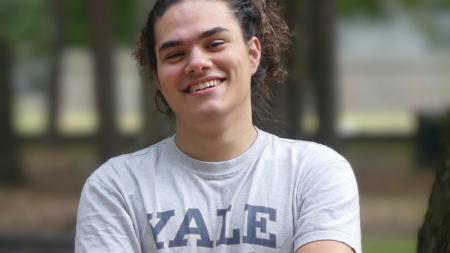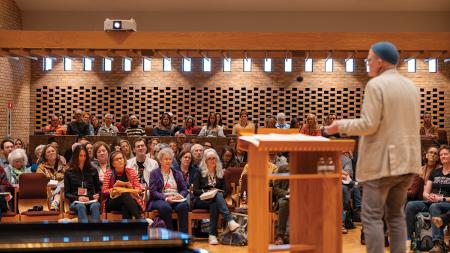Navajo CRC Members Share Christ in Their Jewelry Making

Chris Meehan
Darryl and Rebecca Begay are Navajo artists who say their work as silversmith jewelers, which is gaining a following worldwide, has been infused in the past few years by the movement of the Holy Spirit.
Their artwork includes the intricately carving and setting of precious gems into a range of jewelry that has a notably southwestern U.S. flavor Bracelets with eagles soaring, bolo tie clasps showing desert scenes, and belt buckles featuring dragonflies are among their creations.
Both are members of Church Rock Christian Reformed Church, where Rev. Bobby Boyd has been teaching them and others to be sensitive to the ways, through prayer and praise, God’s Holy Spirit can transform lives.
The Begays especially learned about the Spirit’s work in the past few years as both faced significant challenges.
Rebecca said that as result of what they’ve been through, she has come to see that God’s Spirit works in steady and yet mysterious ways.
“I see that God has changed my thought process,” she said. “The power of the Holy Spirit is in us, and as a Christian I have access to it. The Spirit has helped me so much to grow as an artist.”
Rebecca grew up in Crownpoint, N.Mex., and attended the Christian school there before moving to Rehoboth Christian School in Rehoboth, N.Mex.. That is where one of her teachers, Elmer Yazzie, noticed her talent for drawing and encouraged her to pursue a career in art.
Darryl is from Round Rock, Ariz. While Rebecca was raised in the CRC, his family embraced traditional Navajo beliefs and practices that were mixed with some Baptist teachings — so he also knew about Jesus.
Darryl grew up in a family of artists: his grandmother was a weaver and conducted Navajo blessing ceremonies, and his grandfather was a ceremonial sandpainter.
It was his uncle Bobby Begay, a medicine man and artist, who first taught him jewelry making.
Darryl recalls that one day his uncle, who lived in Round Rock, Ariz., was getting ready for an art show and asked him to make some colorful bracelets out of tufa, a soft, porous desert rock similar to limestone.
“My uncle showed me the basics. I’d never done a tufa casting before, but it felt so easy, so natural,” he said. “When we took the bracelets to the art show, one of the Native artists looked at them and said they weren’t too bad for a beginner.”
Darryl was attending college at the University of Arizona in Flagstaff at the time. When he returned, he decided to forgo a career in accounting, dropped out of the university, and poured himself into working with rocks and stones and shaping them into bracelets, necklaces, earrings, and other items.
At the university he had also met Rebecca, then working on her degree in art education. That was in 1997.
“I remember she was taking a silversmithing class, and I helped her get an A,” he recalled in a soft voice as he glanced at his wife on the other end of the couch.
In the early years of their marriage, the Begays learned how to work together as artists, each complimenting the other’s style and ideas. They began winning awards in Native art shows, and were busy raising their three children. But then Rebecca got sick with a rare illness and was hospitalized for lengthy periods.
“I had to lean on the doctors and medications. I was in a lot of pain and wasn’t always sure what was going to happen to me,” she said. She waited a few moments before adding: “But even though it was very hard at times, I was able to tap into my faith and learned more about the grace of God.”
Doing his best to raise their three children at home while Rebecca was in and out of the hospital, Darryl himself had a long bout with abdominal pain, which finally ended when he had his gallbladder removed.
“We’ve been through the wringer,” said Rebecca. “We went through the storm together. . . . It was so unbearable at times that I felt like quitting, but I kept going, and God walked us through it.”
During that period, as his wife continued to suffer, Darryl wondered if medicine from his past could help bring them comfort and healing.
“At times I was driven to traditional ways, but they could only take me so far,” he said.
Then in 2012, after a long period of searching, Darryl came to realize that Jesus was the answer for him and for his marriage. Today, he and Rebecca are taking courses from the Classis Red Mesa Leadership Development Network to learn how to be church leaders.
“I saw that Jesus was hard-core. He wasn’t afraid; he dealt with issues,” said Darryl. “That was about five years ago. Since then, there’s been no turning back. It’s been all God.”
Through it all they have also been able to keep up their art. Even in the toughest times, images of jewelry to craft came into Darryl’s mind — so when he could, he went into their garage studio to work. Now he is busy making jewelry for clients all over the world.
As Rebecca began to feel healthier, she too has been busy. At times they are joined by two of their children, who are also talented artists.
Smiling in what can only be described as a shy, sensitive way, Rebecca credits Darryl for encouraging and motivating her as an artist, going back to when they first met.
These days she has opened up as an artist. “I’ve let myself go with flowers and butterflies. John 15:5 is my inspiration. By relying on [Jesus] I will bear much fruit.”
Collaborating with Darryl on their tufa or sandstone-cast jewelry, Rebecca often “begins the process by measuring and outlining the realistic figures that often appear on their pieces,” says an online trading post article by the Wheelwright Museum of the American Indian.
“She then begins the carving (sometimes of butterflies), while Darryl does the detailed carving. Both make bezels (the forms into which they) set stones, but it’s Darryl who shapes the turquoise, coral, and other stones.”
Darryl said jewelry dealers and others involved in the gem business send him rare stones on which to carve various images and to set them into pieces of jewelry.
One of his specialties is to work on high-quality natural turquoise, a stone with great depth reflecting ever-shifting qualities. “I have a lot of respect for it. There are so many patterns — flower patterns, ones that are translucent, those that are deep blue. There are different characteristics to each one.”
Holding a rock in his hand, he sometimes wonders how long it took for the turquoise to form, and under which conditions. There may be several possible answers, but in the end, he said, “it has to be God who created it.”
Looking back a few years, the Begays said one of their proudest moments as artists came in 2009 when they won the coveted Best of Show Award at the Santa Fe Indian Market. Titled “Return from the Long Walk,” the entry was a concho belt with 15 separate images in tufa-cast silver.
For them, the belt represented a vision that underlies their work. This piece offered a message about how some Navajos have endured and succeeded despite their removal from ancestral lands in Arizona and internment by the United States government at Fort Sumner, N. Mex., between 1864 and 1868. In the removal, they were forced to walk some 300 miles, and many died in the harsh conditions along the way.
On the belt are Navajo historical figures such as a World War II codetalker, a weaver, a basketmaker, and a major league baseball player. There also is a Navajo man walking west and leading a young girl, her mother, grandmother, and two children riding a horse. The grandmother carries a baby in a cradleboard on her back.
“This is about the Long Walk turned positive,” said Darryl. “My grandparents stressed education and said never to play the victim. We’re concerned that some people are no longer go-getters. I see some traditional people stuck on how they were treated by the early missionaries.”
As the Begays continue their work, they realize that in the Native American art world they are looked on as anomalies who are walking a different path — a path that may include some of the ideas and traditions of the past but is now guided by the Holy Spirit.
“We see ourselves as showing the light of God on the Native American art scene,” said Rebecca. “I think that being able to speak more freely about my faith came after we made that concho belt. I see our role today as encouraging one another and others who want to know more” about the Holy Spirit and faith in Christ.


